
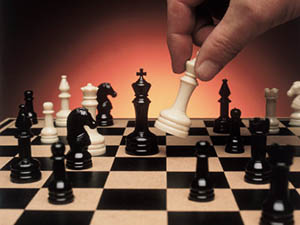
Just like any other sport or game, practice is the key word. But practicing chess tactics doesn't help unless you are practicing the right things!
There are many books out there with thousands of combinations. The problem with many of these chess tactics resources is that all you get is a position and a solution.
It does not provide enough detail to learn. So I invite you to a look to the following tips:
-
Open with a center pawn
Move the pawn in front of either the king or queen two squares forward to open pathways for your bishop and queen.
-
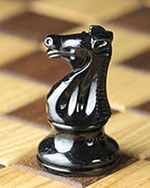
Use first your knights and bishops
Move your knights and bishops toward the center of the board before you move your queen, rooks or king.
Note: Minor pieces should be brought into the game in general before the major pieces.
Knights and bishops can influence the center and create attacking opportunities.
-
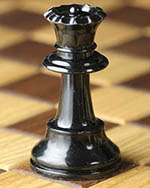
Don't use the queen much early
While the queen is valuable, this also makes it vulnerable.
Every time it is attacked by a weaker piece, it must move to avoid capture, because trading a queen for another piece is never a good idea.
-
Master your openings
Some openings are complex to understand (like Sicilian Defense). Then pick beter a more compact opening.
Make sure you choose openings that fit your style. e.g. If you are a tactical player, do not choose the English opening with white, and the French Defense with black.
-
Don't waste moves
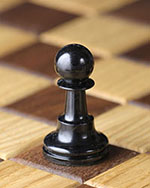
Time is a very important element of chess. The player whose men are ready for action sooner will be able to control the course of the game.
Don't make too many moves with your pawns or try to pick off your opponent's pawns.
Beginning players like to move their pawns to gain space on the chessboard, but you can't win with pawns alone.
Other pieces can move farther, thus they can threaten more targets at once and it's general a good idea to bring out a few soon.
Instead of just moving pieces out, try to determine the best square for each piece and bring it there in as few moves as possible.
-
Avoid moving a piece twice during the opening
Don't move the same piece multiple times in the opening unless necessary.
It is more important to bring many pieces into play because attacks using only one or two pieces are rarely successful.
-
Control the center
In most cases, the player that controls the four center squares will have the better game:
- A piece in the center controls more of the board.
- Control of the center provides an road for your pieces to go from one side of the board to the other.
- You also will be able to mount a successful attack there before you can bring over enough pieces to defend.
In general, never develop your chess pieces exclusively on one side.
-
Watch your opponent's moves
Always yourself the following questions:
- What did my opponent's last move do?
- What is he up to?
- Is any of your pieces in danger?
- Is he laying traps to capture your pieces?
-
Make your best possible move
After you watched your opponent, decide on your own plan or counter.
Always look at all your possibilities. Look at moves that would capture your opponent's men or threaten his king first.
Ask yourself the following questions:
- Does this move help to defend against my opponent's threats?
- Will the piece I move be safe on its new square?
- Will the piece I'm moving go to a better square than his current one?
- Can I improve my position even more with another piece?
And always double-check your moves before you play them. Ask yourself if this move leaves something valuable unprotected?
-
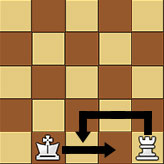
Castle on time
When you castle, you bring your rook into play and move your king into safety.
If your opponent neglects to castle, you might be able to launch an attack on his king.
-
Know what the pieces are worth
When you are considering giving up some of your pieces for some of your opponent's, you should think about the values of them.
The player whose pieces have a greater total value haves a big advantage.
-
Know when to trade pieces
Since you will have many chances to exchange pieces on an "even" basis, it's useful to know when you should or shouldn't do this.
In general, if you have the initiative, try not to exchange men unless it increases your advantage in some clear way.
The fewer pieces each player has, the weaker the attacking player's threats become and the easier it is to defend.
Don't trade pieces when your oppoment has only little space for his pieces to move.
Often it is a good idea to trade pieces if this give your opponent "doubled pawns".
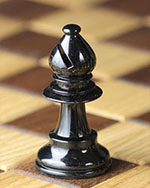
The player who has more high valuable pieces is usually benefitting from a trade.
Avoid exchanging bishops for knights early in the game.
In the beginning, a knight and a bishop are about equally powerful, but later the bishop can exert its influence in all parts of the board at once (the board is more empty to move), while the knight still takes a long time to get anywhere.
-
Take your time to play
If you see a good move, sit on your hands and look for a better one.
Patient thinking is the key to chess success.
Always check and double check possible moves.
-
Make the transition in the middlegame
When you developed your knights, bishops and pawns, the middlegame starts.
Now, look to ways to attack your opponent's unprotected pieces. But also look at what will happen to your piece if you take his. Is your attacking piece still safe? And if not, then see if the trade is worth.
Always be looking for ways to get a lot of your pieces into position to attack the opponent's king.
-
Have a plan
Players often forget to look at the big picture and make sure the moves they are making are part of a bigger plan.
When you develop a plan, your pieces should work in harmony. Your pieces are your team and to be a good coach, you have to use all their strengths together.
e.g. if you want control of all the squares in a particular area (where is the opponent's king) of the board, you must plan this with much pieces.
-
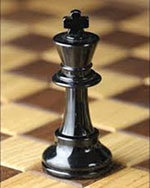
Save the king
Often a player thinks too much about his plan to attack the opponent and forgets that this opponent is also a king hunter.
Before every move you do, you should check for threats against your king.
Keep also in mind that castling early in the game can bring your king into more safety.
-
Think about the endgame
Pawn structure is crucial in the endgame. When you capture one of your opponent's men with a pawn, you'll often create an open file that will help your rooks and queen to reach your opponent's side of the board.
But remember that doubled pawns cannot defend each other. They are liability in the endgame.
In the endgame the king is not a liability anymore. Instead of protecting him, you can use him as a very dangerous weapon.
-
Analyze Your Games
No matter what the result of the game was, take the time to go over them carefully.
You learn the most from your own mistakes!
Video Tutorial
Continue Reading


